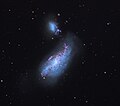NGC 4485
| NGC 4485 | |
|---|---|
 NGC 4485 taken by Hubble.[1] | |
| Observation data (J2000 epoch) | |
| Constellation | Canes Venatici[1] |
| Right ascension | 12h 30m 31.113s[2] |
| Declination | +41° 42′ 04.22″[2] |
| Redshift | 0.0016[3] |
| Heliocentric radial velocity | 483[4] |
| Distance | 29.1 Mly (8.91 Mpc)[4] |
| Apparent magnitude (V) | 11.93[3] |
| Apparent magnitude (B) | 12.32[3] |
| Characteristics | |
| Type | IB(s)m pec[5] |
| Size | 11000 ly |
| Other designations | |
| 2MASX J12303111+4142042, NGC 4485, UGC 7648, MCG +07-26-013, PGC 41326, VV 30b, KPG 341a[3] | |
NGC 4485 is an irregular galaxy located in the northern constellation of Canes Venatici. It was discovered January 14, 1788 by William Herschel.[6] This galaxy is located at a distance of 29[4] million light years and is receding with a heliocentric radial velocity of 483 km/s.[4]
NGC 4485 is interacting with the spiral galaxy NGC 4490 and as a result both galaxies are distorted and are undergoing intense star formation. They have a projected separation of 9.3 kpc and are surrounded by an extended hydrogen envelope with a dense bridge of gas joining the two. Both galaxies are otherwise isolated and of low mass. The star formation rate in NGC 4485 is 0.22 M☉·yr−1.[7]
Gallery
-
 NGC 4485 and NGC 4490.
NGC 4485 and NGC 4490. -
![Interaction between them created a stream of material about 25 000 light-years long.[8]](//upload.wikimedia.org/wikipedia/commons/thumb/9/94/On_the_verge_NGC_4485.jpg/120px-On_the_verge_NGC_4485.jpg) Interaction between them created a stream of material about 25 000 light-years long.[8]
Interaction between them created a stream of material about 25 000 light-years long.[8]
References
- ^ a b "Starbursts in the wake of a fleeting romance". ESA/Hubble Picture of the Week. Retrieved 13 May 2014.
- ^ a b Skrutskie, Michael F.; et al. (1 February 2006). "The Two Micron All Sky Survey (2MASS)". The Astronomical Journal. 131 (2): 1163–1183. Bibcode:2006AJ....131.1163S. doi:10.1086/498708. ISSN 0004-6256. S2CID 18913331.
- ^ a b c d "NGC 4485". SIMBAD. Centre de données astronomiques de Strasbourg. Retrieved 13 May 2014.
- ^ a b c d Tully, R. Brent; et al. (2016). "Cosmicflows-3". The Astronomical Journal. 152 (2): 21. arXiv:1605.01765. Bibcode:2016AJ....152...50T. doi:10.3847/0004-6256/152/2/50. S2CID 250737862. 50.
- ^ "Results for object NGC 4485 (NGC 4485)". NASA/IPAC Extragalactic Database. California Institute of Technology. Retrieved 2021-02-10.
- ^ Seligman, Courtney. "NGC Objects: NGC 4450 - 4499". Celestial Atlas. Retrieved 2021-12-26.
- ^ Pearson, Sarah; et al. (November 2018). "Modelling the baryon cycle in low-mass galaxy encounters: the case of NGC 4490 and NGC 4485". Monthly Notices of the Royal Astronomical Society. 480 (3): 3069–3090. arXiv:1807.03791. Bibcode:2018MNRAS.480.3069P. doi:10.1093/mnras/sty2052.
- ^ "Hubble Observes Creative Destruction as Galaxies Collide". www.spacetelescope.org. Retrieved 16 May 2019.
External links
 Media related to NGC 4485 at Wikimedia Commons
Media related to NGC 4485 at Wikimedia Commons
- v
- t
- e
- Extragalactic astronomy
- Galactic astronomy
- Galactic coordinate system
- Galactic habitable zone
- Galactic magnetic fields
- Galactic orientation
- Galactic quadrant
- Galaxy color–magnitude diagram
- Galaxy formation and evolution
- Galaxy rotation curve
- Gravitational lens
- Gravitational microlensing
- Illustris project
- Intergalactic dust
- Intergalactic stars
- Intergalactic travel
- Population III stars
- Galaxy X (galaxy)
 Category
Category Portal
Portal
 | This galaxy-related article is a stub. You can help Wikipedia by expanding it. |
- v
- t
- e

![Interaction between them created a stream of material about 25 000 light-years long.[8]](http://upload.wikimedia.org/wikipedia/commons/thumb/9/94/On_the_verge_NGC_4485.jpg/120px-On_the_verge_NGC_4485.jpg)












